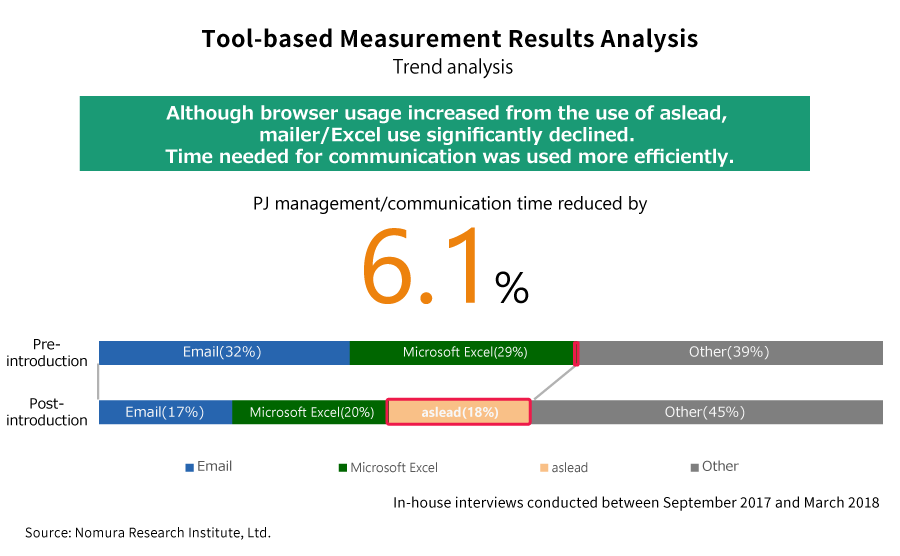
Achieving Smoother Communication and Higher Productivity in Remote Work
With the Covid-19 pandemic continuing, the need to take advantage of remote work has become urgent. We now know that making effective use of remote work not only requires maintaining hardware such as PCs and networks, but also requires ingenuity when it comes to intangibles, including communication and work styles. We spoke with Nomura Research Institute (NRI) members Hiroshi Noto and Jyonghyo Chang about how to achieve smoother communication and improve productivity in remote work.
What is needed to establish new workstyles
--- What issues have become apparent through the spread of remote work?

Noto: Even here at NRI we experienced a semi-compulsory remote work situation because of the Covid-19 crisis, and thus many of us realized the advantages it offers. I personally have been dropping off and picking up my child at preschool in the mornings and evenings; things like that have become easier to manage than before. For people like us who work in the IT field remote work has a lot of advantages, and I’m sure there are many who don’t want their lives to return to how they used to be. For companies as well, having a variety of workstyle options is arguably more effective in terms of securing diverse human resources.
That said, I often hear people express concerns about how difficult it is to grasp how someone else’s work is progressing, or how hard it is to achieve the kind of close communication they’ve traditionally had. It’s only been about half a year since remote work was begun in earnest, so people have been able to work as an extension of the connections they’ve made thus far. But the trouble is that if this goes on for some years, with new members joining the company, it will become more difficult to foster communication among new and existing company members.

Chang: Since people are unable to see their colleagues’ faces, I’m also worried that even if workers are struggling with their tasks or experiencing some kind of trouble, these problems may be going unnoticed. If these circumstances are left as-is, it could produce a greater sense of alienation, and could lead to employees losing their motivation to work. I’m also hearing from management-level persons that they’re worried about not being able to know what their staff are doing as quickly as if they were in the same physical office space. When it comes to work, it’s said that results are what matter, but the process itself is likewise important, and if you miss the timing to make a necessary course correction, you could end up sustaining heavy losses. Things you used to be able to resolve back when everyone was in the office just by going and talking to someone have now become problematic, because remote work makes it difficult to see your colleagues’ situations. Should things continue this way, productivity could decline more and more the longer remote work lasts. If remote work continues to be used as one type of workstyle, we will need to find some way of ensuring both that productivity is maintained and improved and that smooth communication is achieved.
Balancing communication and security in maintaining productivity
--- In NRI’s case, has the transition to remote work gone smoothly?
Noto: For NRI, my sense is that the transition is going well. Even with our members working apart from each other in separate locations, as long as they are able to communicate in a similar fashion to how it was before, there’s little stress. The solution “aslead”, which we’ve been using since before the Covid-19 crisis, was originally designed for the system development team to share information and efficiently collaborate, has come to be used not just for development but in various places within the company because it increases the amount of communication among team members and reduces the time spent on meetings and emails. One item of feedback we’ve received was that aslead is allowing team members to do their work in about the same way as before even at home, and it’s thanks to this tool that they’re managing to cope with the pandemic.
Chang: The most important point is that our team members’ activities—for instance, the status of the tasks they’re working on or the state of communication they have with someone—has become more open to the entire team, including the actual content of those activities. With emails only certain people are privy to the content, and tasks being managed by an individual person’s tools can’t be shared within the team. Using aslead makes it possible to share information and manage tasks among the whole team, and allows you to communicate via chat, so you can always be aware of who is doing what and can make immediate course corrections.
Noto: In order for numerous members to collaborate and carry out their work, multiple tools such as chat or search tools need to be used, and skillfully coordinating these tools is aslead’s strength. And while these kinds of tools are often provided as a cloud-based service, there are a lot of companies that can’t use them for security reasons – aslead, on the other hand, uses both cloud-based and on-premises infrastructure to take advantage of remote work while guaranteeing security.
--- Could you also talk about contributions made to productivity?
Chang: We analyzed the extent to which the time required for project management or communication had been reduced. What we found was that although people’s browser usage time for using aslead increased, their use of mailers or of Excel for task management declined significantly, with a total time savings of 6.1%. When we asked about how much time people felt they’d saved, the average answer we got came out to 48.7 minutes, and so it seems that in an intuitive sense the time-saving effect is greater than what the measurement results imply. Using aslead enables people to work more efficiently than they would when writing emails, and it boosts the speed at which they can share information and knowledge so it cuts down on the number of meetings being held. I think that sort of aspect is well adapted to the telework era.

Aiming to provide solutions adapted to social changes
--- Finally, please tell us a little about the prospects going forward.
Noto: In April 2020 when the state of emergency was declared and companies adopted remote work all at once, it was problematic that our development partners were forced to come to the office for security reasons. A similar situation also arose at NRI, which is why we implemented the “aslead Remote” service in a brief period of about one-month, which allowed staff members to safely use their PCs at a remote base home or elsewhere. Going forward as well, we plan to propose solutions with the sense of urgency to respond to conditions and changes in the outside world.
While there are likely many people teleworking at present, I think there are also a lot of people on duty at the office, coming in and doing their duties onsite. Even at NRI the ratio is about equal (as of December 2020). This ratio may change depending on social conditions and the timing, or may vary from company to company, but the format whereby colleagues in separate locations do their work cooperatively will probably become even more typical going forward. If that happens, I think some of those who are not present at the company could experience a sense of estrangement. I believe we’ll see new arrangements that will alleviate the feeling of alienation by allowing people to feel like they’re coming together and working together despite the physical distance between them. I’d also like to develop tools that help increase people’s motivation and unleash their creativity.
Profile
-
Jyonghyo Chang
-
Hiroshi Noto
* Organization names and job titles may differ from the current version.